HGH: The Ultimate Guide (Dosage, Cycles, Stacks)
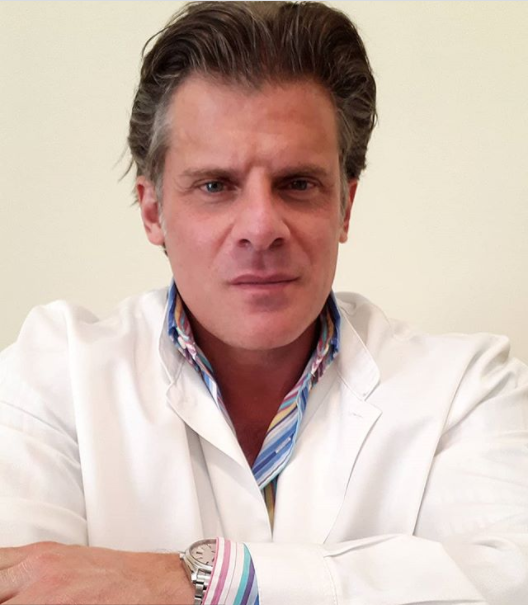 Disclaimer: The following article is for educational purposes only and does not promote the use of illegal substances. If you have any questions or concerns, Dr. Touliatos is currently available for consultation.
Disclaimer: The following article is for educational purposes only and does not promote the use of illegal substances. If you have any questions or concerns, Dr. Touliatos is currently available for consultation.
What is HGH?
HGH is a naturally occurring peptide hormone responsible for skeletal muscle growth and cell production.
HGH also affects the metabolism and adipose tissue, causing significant subcutaneous fat loss in individuals with high levels of this hormone.
Natural HGH levels are often determined by various factors, including:
- Genetics
- Sleep
- Age
- Exercise
- Overall health
Why do people take HGH?
We have seen adults experience a 15% drop in growth hormone every 10 years (1), contributing to weight gain, wrinkles, muscle loss, and decreased energy.
Consequently, men and women around the world are taking artificial HGH to reverse the aging process, enhance athletic performance, and improve body composition.
Contents
- 1 What is HGH?
- 2 Why do people take HGH?
- 3 What are the origins of HGH?
- 4 What are the benefits of HGH?
- 5 What are the side effects of HGH?
- 6 HGH cycles
- 7 HGH before and after (without insulin)
- 8 HGH before and after (with insulin)
- 9 HGH before and after (female results)
- 10 Is HGH suitable for women?
- 11 Frequently asked questions
- 12 What are the pros and cons of HGH?
What are the origins of HGH?
In 1985, the FDA approved the first growth hormone compound, known as somatrem (Protropin), in an attempt to treat endogenous HGH deficiency and growth disorders.
Despite its overall success, scientists found incidents of somatrem causing antibody reactions, reducing its biological availability and effectiveness.
In 1987, thanks to recombinant DNA technology, somatropin was formulated, a drug with an identical structure to natural HGH secreted by the pituitary gland.
Thus, somatropin became a purer HGH derivative than its predecessor and is commonly utilized by bodybuilders today, with widespread production in pharmaceutical and underground labs.
Disclosure: We do not accept any form of advertising on Inside Bodybuilding. We monetize our practice via doctor consultations and carefully chosen pharmaceutical recommendations, which have given our patients excellent results.
Approved Testosterone Source

If you suffer from hypogonadism and require testosterone for medicinal purposes, we recommend Olympus Men's testosterone replacement therapy (TRT) program.
We have found Olympus Men to be the most cost-effective provider, with treatments ranging from $148 to $200 per month. In contrast, other programs can cost up to $500 per month.
Inside Bodybuilding does not condone the use of anabolic steroids via illegal means or for cosmetic use.
10% discount code: Inside.
What are the benefits of HGH?
- Increase in height (during puberty)
- Muscle building
- Fat loss
- Anti-aging
- Lack of withdrawal (post-cycle)
Height increase
Children who have not experienced a standard growth spurt appropriate for their age can be prescribed HGH by a pediatric endocrinologist. We have seen this accelerate growth and significantly improve their quality of life.
However, HGH will not positively influence height during the post-puberty years due to the fusing of growth plates.
Muscle building
HGH is not an anabolic steroid; however, it does have muscle-building properties, albeit weaker than steroids in our experience.
In medicine, HGH has been prescribed for the treatment of cachexia (muscle wasting), including AIDS.
HGH helps the body shift from a catabolic environment by increasing nitrogen retention and protein synthesis in the muscle cells, thus promoting weight gain in the form of lean mass.
Fat loss
HGH’s most prominent effect in terms of body composition is subcutaneous fat loss.
Generally, HGH’s results in terms of decreased adipose tissue outweigh the anabolic effects of HGH, significantly leaning a person out and increasing muscle definition.
Anti-aging
In our testing, we see HGH stimulating collagen synthesis, notably causing vast anti-aging effects.
Collagen is a protein that plumps out the skin, increasing elasticity, decreasing wrinkles, and preventing sagging.
Collagen is also critical for hair and nail health, with it thickening hair follicles, inhibiting gray hairs, and reducing nail breakage.
These benefits are contrary to many anabolic steroids, which we have found to reduce collagen production and accelerate aging.
Users may not only look visibly younger but also feel it on HGH, with our patients typically displaying higher energy levels due to HGH’s effect on carbohydrate metabolism and its spiking of blood glucose.
HGH also increases cognitive ability due to growth hormone receptors being expressed in brain regions, including the cerebral cortex, choroid plexus, and hippocampus (2).
Note: Although HGH does provide anti-aging effects, it is likely to shorten a person’s lifespan due to greater IGF-1 output (3).
Lack of withdrawal
We have not found HGH to cause a comedown effect upon cycle cessation, unlike steroids, so post-cycle therapy is not required.
Post-cycle therapy (PCT) aids in the recovery of the HPTA (hypothalamic-pituitary-testicular axis) following a steroid cycle, enhancing endogenous testosterone production.
Without PCT, low testosterone symptoms can persist for several months.
Although HGH does suppress natural growth hormone levels, we find they often return to normal levels in a matter of days (significantly faster than HPTA recovery). Thus, HGH users do not typically suffer physiologically or psychologically from conditions such as catabolism, increased fatigue, or decreased well-being.
What are the side effects of HGH?
There is a lack of long-term studies performed on HGH; however, we have anecdotal evidence of HGH causing the following:
- Heart disease
- Diabetes
- Possibly carcinogenic
- HGH gut
- Tumor growth
- Hypothyroidism
- Bone/tissue growth
- Numbness in feet and hands
Heart disease
Like anabolic steroids, we have found that left ventricular hypertrophy can occur from HGH use (4), increasing the risk of heart disease.
We have also seen HGH having cardiovascular benefits when used in the treatment of patients deficient in endogenous growth hormone (5), having a paradoxical effect and causing cardiac atrophy.
Diabetes
HGH has diabetogenic effects related to its metabolism of carbohydrates, causing blood sugar levels to rise and thus increasing the risk of type 2 diabetes.
Possibly carcinogenic
We do not have enough data to unequivocally state that HGH causes cancer; however, Dr. Thomas O’Connor has anecdotal evidence to suggest a possible link between HGH use and the development of various cancers.
Dr. Thomas O’Connor has seen the following cancers transpire in patients utilizing growth hormone:
- Melanomas
- Esophageal cancers
- Brain cancers
- Heart tumor (single case)
- Gastrointestinal tract cancer
Such patients had used HGH for several years in combination with various anabolic steroids, causing suspicion that growth hormone was the culprit.
Ex-NFL star Lyle Alzado also believed performance-enhancing drugs (including HGH) were the cause of the brain lymphoma he suffered, sadly leading to his death in 1992.
Our concern is that HGH significantly stimulates IGF-1, a surrogate marker for cancer.
IGF-1 is used by medical doctors to detect potential cancer risk and tumor growth in patients.
Thus, by spiking HGH, users may effectively be increasing their own risk for cancer or worsening any existing (unknown) tumors.
HGH gut

HGH gut is a term used in bodybuilding to describe the protruding effect of the abdomen, seen in many IFBB competitors today.
This distended effect is indicative of high levels of visceral fat. It is a misconception that HGH is the sole cause of this appearance, as it actually reduces visceral fat by stimulating lipolysis, which has the opposite effect.
However, we see many bodybuilders combine HGH with insulin during a cycle for more anabolism due to its efficient shuttling of nutrients into the muscle cells.
They do this because insulin increases IGF-1 receptor upregulation and decreases IGF protein binding 1, thus creating a particularly anabolic environment when synergistically used with HGH (which has IGF-1 stimulating properties).
Insulin, however, promotes lipogenesis (fat storage) in users, causing a fat look to the body, which is evident even in bodybuilders with a low body fat percentage.
Thus, HGH gut can occur after prolonged use, with the presence of insulin, in our experience.
Hypothyroidism
Research suggests hypothyroidism may occur in HGH users due to the depletion of potassium, sodium, and phosphorus, causing a T3 (triiodothyronine) deficiency.
This is surprising considering T3 is a potent fat-burning hormone, and HGH also stimulates lipolysis (fat loss).
Interestingly, our doctors have not observed any reductions in T3 levels in patients utilizing HGH. Thus, it is possible that such a T3-inhibiting effect may only occur in HGH-deficient individuals.
Bone/tissue growth
Acromegaly, causing the enlargement of bones and tissues, is common when taking HGH for a substantial amount of time.
One bodybuilder took HGH for 10 years continuously and reported an increase in foot hypertrophy, going from size 12 to 15 (6).
His skull was also enlarged, having previously worn a size 7 3/8 cap and later going up to 7 5/8. He also observed growth in the hands, wrists, and stomach.
Gynecomastia
Interestingly, we have found gynecomastia to be a possible side effect of HGH (7).
We do not know for certain how breast tissue accumulates in men on HGH; however, it may be attributed to elevations in the female sex hormone, progesterone.
Medical research and our own tests show that HGH stimulates progesterone levels via luteal steroidogenesis (8), thus potentially causing gynecomastia in a similar way to Deca Durabolin.
We have found that an AI (aromatase inhibitor), such as anastrozole, is often successful in safeguarding HGH users from gynecomastia, with research showing it to be an effective inhibitor of progesterone receptor expression (9).
Numbness in feet and hands
Some of our patients have experienced numbness in the hands, otherwise known as carpal tunnel syndrome (CTS).
This may occur on HGH due to an increase in sodium uptake and extracellular fluid (water retention). This excess fluid in the synovial tissue compresses the median nerve, resulting in reduced function (10).
Legal HGH alternative
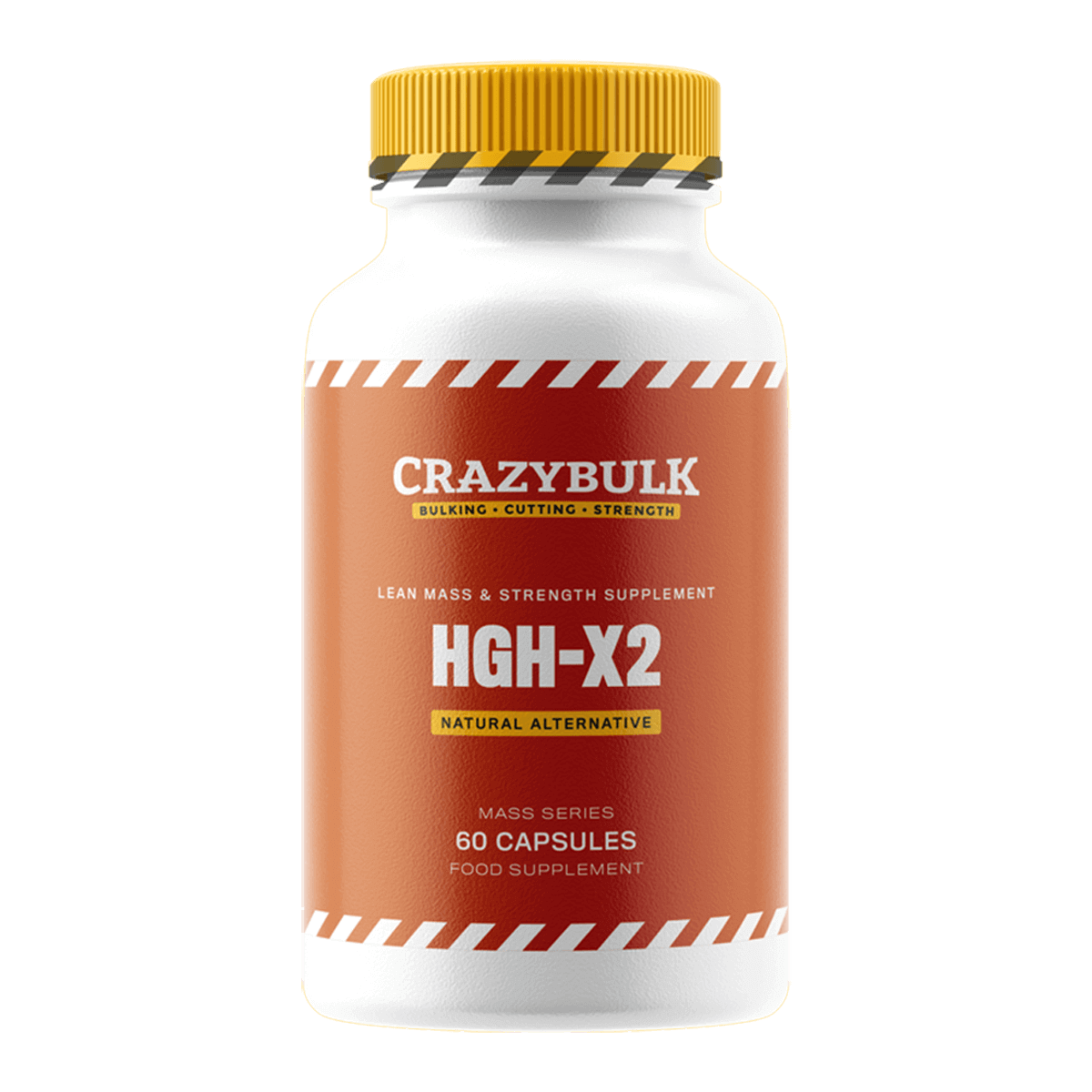
HGH-X2 is our #1 rated legal human growth hormone product. It replicates the muscle-building and fat-burning effects of HGH, but without the unwanted side effects.
It is FDA-approved and can be purchased online without a prescription.
HGH-X2 is best suited for men or women wanting to enhance fat loss, muscle tone and anti-aging; without the risk of increased blood pressure, diabetes or tumor growth.
HGH cycles
When used in medicine to treat intrauterine growth retardation, dosages of 1-3 IU per day are typically administered.
When used for performance enhancement purposes, 2-4 IU per day are taken, with a maximum dosage of 6 IU used by elite bodybuilders to promote further mass gain.
HGH cycles usually last anywhere from 6 to 24 weeks, with 16 weeks being the average duration for a standard bodybuilding cycle.
HGH-only cycle

We find that HGH is not typically taken by beginners but by more experienced PED users attempting to enhance their muscle gains.
Beginners with significant muscle size will typically take bulking steroids, such as:
Then, after hitting a plateau, they may introduce HGH for further growth and fat loss.
However, if beginners do not want to experience significant muscle gains but instead milder increases in hypertrophy (size), the above cycle may be taken.
In our experience, Anavar and Primobolan are mild steroids that can produce similar results (with less toxicity) to HGH. We must stress that the long-term effects of HGH are still relatively unknown.
HGH and testosterone
HGH/testosterone is a common cycle used to significantly enhance:
- Muscle building
- Strength
- Fat loss
Thus, a HGH/testosterone stack could be used for bulking or cutting.
We see testosterone taken by beginners as a first steroid cycle, helping them to build large amounts of muscle while reducing subcutaneous fat.
30 lbs of lean mass gained is a typical outcome in our patients when taking testosterone for the first time in moderate dosages (combined with weight training).
Adding testosterone to this stack is optimal for users wanting more pronounced muscle gains compared to taking HGH alone.
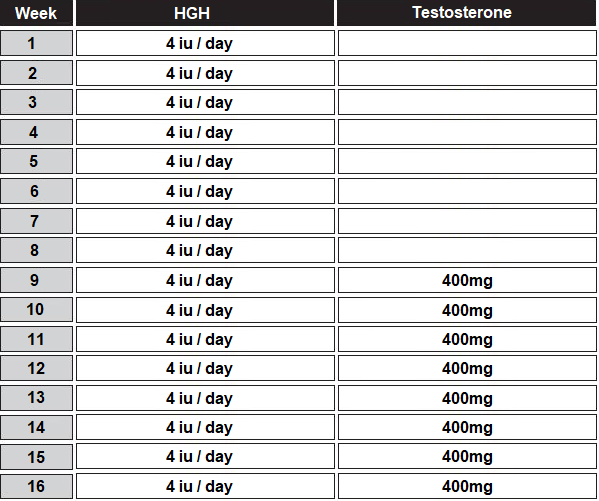
Side effects
The addition of testosterone will add some cardiotoxicity, causing adverse fluctuations in LDL cholesterol. Such deteriorations in blood lipids from testosterone are more modest compared to other anabolic steroids, based on our testing. Testosterone does not cause notable hepatotoxicity, being an injectable.
However, androgenic side effects may occur with the addition of testosterone, such as:
- Accelerated MPB (male-pattern baldness)
- Acne vulgaris
- Prostate enlargement
These adverse effects occur due to heightened DHT levels damaging hair follicles on the scalp and the sebaceous glands becoming overstimulated, resulting in excess sebum secretion (blocking the pores).
Stacking HGH with testosterone will also have a transient effect on testosterone levels, initially increasing during a cycle but then decreasing post-cycle. Consequently, low testosterone symptoms can persist for several months unless certain PCT medications are taken to restore the HPTA.
We do not find testosterone suitable for women due to its androgenic nature, which causes high incidents of masculinization.
HGH, T3, and Anavar
This is a cutting cycle and one of the most potent combinations for prominent fat loss in our experience.
T3 (Cytomel) is a powerful fat-burning hormone used as a prescription medicine for treating obesity and hypothyroidism. Bodybuilders often use T3 to raise their BMR (basal metabolic rate) and enhance lipolysis, maximizing fat burning before a competition.
We find that the gradual tapering of T3 during this cycle (with steady increases and decreases in dosage) is optimal to reduce side effects and prevent endogenous T3 shutdown post-cycle.
Anavar is one of the most commonly used cutting steroids, dramatically enhancing fat loss while retaining (or adding) lean muscle.
The presence of Anavar is critical in this cycle, not only from a fat-burning perspective but also to prevent the body from shifting into a catabolic state. T3 can burn muscle tissue as well as fat stores when taken without anabolic agents; thus, running T3 by itself is a potential disaster for a bodybuilder.
100 mg/week of testosterone can also be added to this stack to increase anabolism without adding any notable water retention due to this low dose. Testosterone is commonly taken alongside T3 and Anavar for the last 8 weeks of this cycle.

Side effects
We regularly see endogenous T3 levels become suppressed post-cycle after taking exogenous T3. It can take approximately 3–4 weeks for natural levels to return to normal. During this time, a person’s metabolism will become significantly slower, making it easier to overeat.
Thus, users must be cautious of this effect and lower their calories accordingly (as we see consumers typically gain weight back by eating in a caloric surplus).
Anavar is a mild steroid, with few side effects reported by our patients. However, alterations in cholesterol levels and blood lipids are still to be expected. We have found that supplementing with 4 grams of fish oil daily effectively lowers LDL cholesterol and reduces cardiovascular strain.
Anavar is an oral steroid and thus C-17 alpha-alkylated, enabling maximum absorption into the bloodstream.
Oral steroids may be convenient; however, they are hepatotoxic, and thus AST and ALT liver enzymes often rise, indicating stress or damage to the liver. We have not found Anavar to be particularly hepatotoxic; therefore, liver inflammation is likely to be mild when consuming moderate dosages.
The presence of Anavar will also cause some natural testosterone suppression. Our patients’ labs do not indicate this being an aggressive shutdown of the HPTA; however, it may take several weeks for peak testosterone function to return. A PCT may or may not be used, depending on how the user is feeling in terms of energy, libido, and mood.
Note: Women should only use 10 mg of Anavar for the last 4-5 weeks of this cycle to prevent masculinization.
Best HGH stack
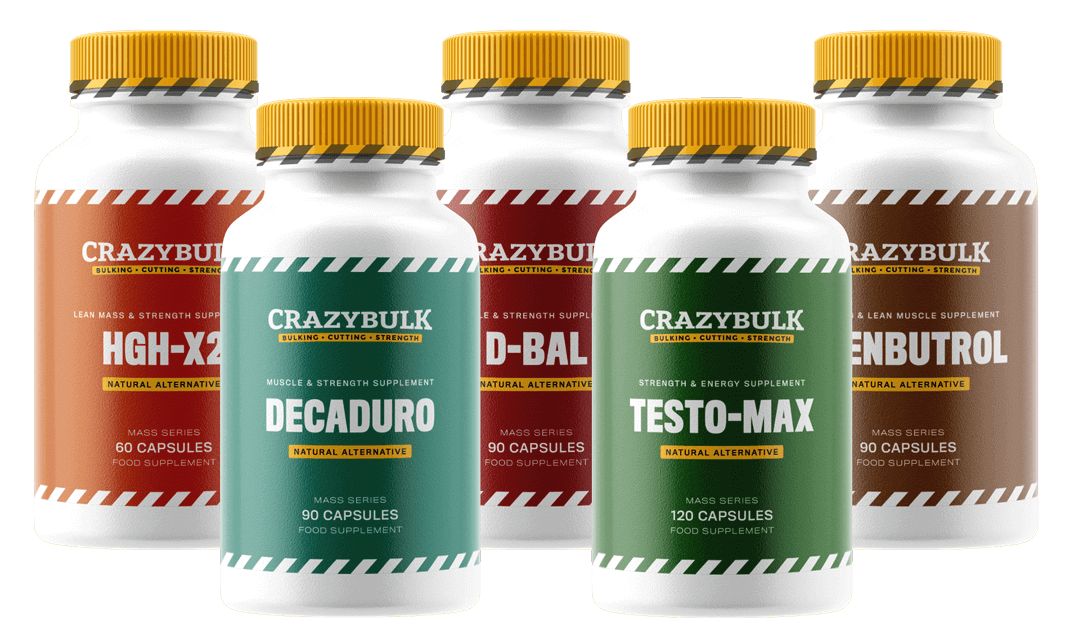
This growth stack combines 5 legal steroid alternatives for maximum lean muscle gains, and simultaneous fat loss.
HGH-X2 (HGH) is combined with Decaduro (Deca Durabolin), D-Bal (Dianabol), Testo-Max (Sustanon 250) and Clenbutrol (Clen).
Stacking in this way can significantly enhance a user's results, compared to HGH-only cycles.
HGH before and after (without insulin)
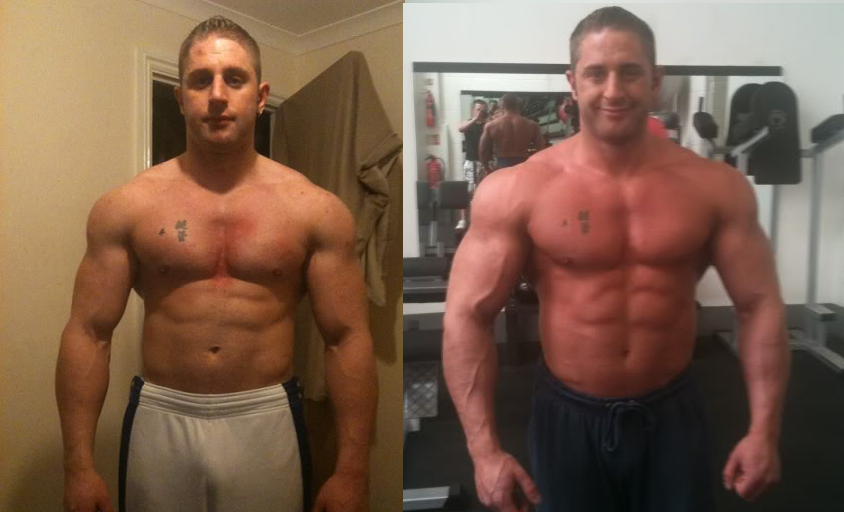
These are the results of a user who blasted HGH for 10 days, taking megadoses of 16 IU per day. Blast and cruise is a method sometimes utilized by bodybuilders, involving long-term drug use rather than cycles.
Bodybuilders significantly increase the dosage, known as a blast, to overcome a plateau or maximize gains in a short period of time. This user experienced notable increases in muscle hypertrophy and fat loss from this protocol.
However, we have seen that long-term use of AAS or HGH like this can result in the shutting down of the endocrine system (and thus is not recommended).
HGH before and after (with insulin)

We cannot confirm whether this bodybuilder has used HGH or insulin. However, in our experience, these results are typical when combining HGH and insulin together.
He has experienced noticeable:
- Muscle growth
- Decreases in subcutaneous fat
- Increases in muscle definition and vascularity.
However, he also displays higher levels of visceral fat, hence the increased protrusion of the midsection (known as HGH gut).
HGH before and after (female results)

This before-and-after picture is the result of long-term HGH use (several years of injections). This female user administers HGH every day for weight loss and anti-aging benefits; however, the dosages utilized are unknown.
Is HGH suitable for women?
Women are limited in regard to what steroids they can use, as many compounds cause virilization side effects. However, we have found that masculinization does not occur on HGH, as it does not elevate androgen hormones such as free testosterone. Therefore, women can successfully use HGH to burn fat and enhance muscle tone without forming male characteristics.
It may also be argued that HGH’s effects are more beneficial for women than men regarding anti-aging, fat loss, hair, skin, and nail health. However, one downside we see with HGH for women is bone and tissue enlargement (present in long-term use). Females are inherently the smaller sex; thus, the reality of their feet, hands, and skull growing larger may not be desirable. Whereas for a man, this may not be troublesome.
Frequently asked questions
Is HGH legal?
HGH is legal when prescribed for medicinal purposes, i.e., for dwarfism or growth deficiency that greatly impacts overall well-being.
However, HGH is illegal for cosmetic purposes, i.e., buying it on the black market to lose fat and build muscle. This is due to it being included in the 1990 Anabolic Steroid Control Act, meaning non-medical distribution or possession is a federal crime.
How do people acquire HGH?
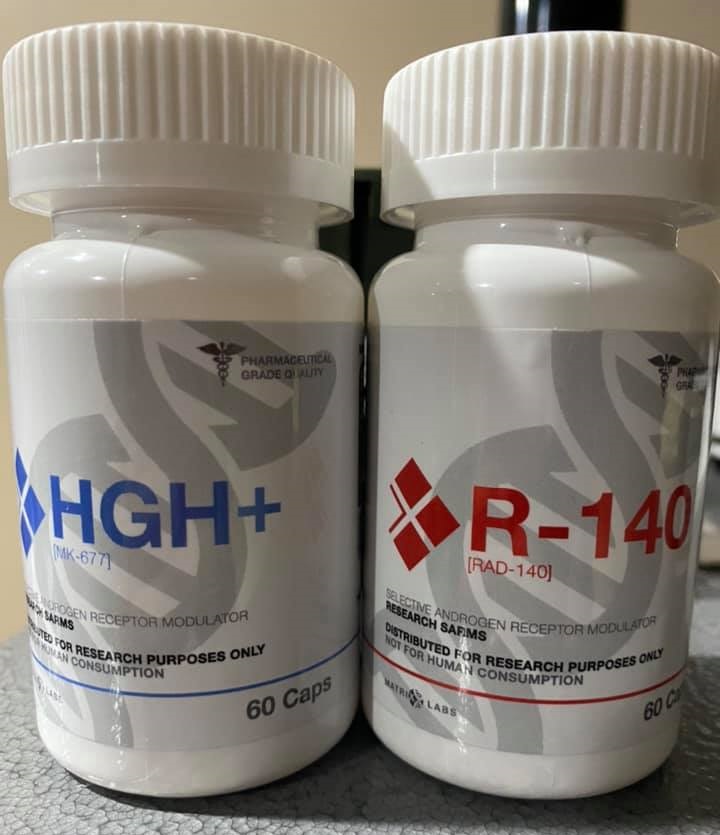
If a person is deficient in HGH, they may be prescribed it by their doctor. However, if a bodybuilder wants HGH to build muscle, then he or she will buy it from the black market.
People find dealers by asking around at gyms or buying from websites online. Users commonly purchase pharmaceutical or UGL (underground lab) products on the black market.
What is pharmaceutical HGH?
Pharmaceutical HGH is formulated in a certified lab and is sometimes sold (illicitly) by someone who has been medically prescribed this drug. UGL HGH is typically formulated by someone with zero medical expertise or qualifications and synthesized in a non-certified lab (usually their own home). UGL HGH is considerably cheaper; however, it poses more risks due to hygiene issues or possible contamination. With UGL products, there is also a chance of the product being diluted or counterfeited.
Are there any scams associated with HGH?
A typical scam we see on the black market is to label hCG (human chorionic gonadotropin) as HGH, with both compounds sharing a similar visual resemblance. HCG is a female pregnancy hormone but is sometimes used by bodybuilders during PCT to stimulate endogenous testosterone production.
Some of our patients have previously tested the legitimacy of various HGH somatropin products by taking a pregnancy test a few days into their cycle. They would administer an injection at night, then the following morning take a pregnancy test. If positive, it indicates a counterfeit product, with hCG being detected.
How much does HGH cost?
HGH can cost $4,000 and upwards per month, even when utilizing lower dosages for anti-aging purposes.
Will HGH show up on a drug test?
WADA (World Anti-Doping Agency) and the IOC (International Olympic Committee) list HGH as a banned substance; thus, athletes may fail drug tests if caught with HGH in their system.
The accuracy of such tests has been questioned by athletes and our doctors, including Dr. Thomas O’Connor, who branded them as “unreliable” (11).
However, standard drug tests for the army, police, and other employment do not typically detect HGH or anabolic steroids.
This is because such tests are expensive; thus, general tests are instead used to detect recreational drug use, such as marijuana, cocaine, opiates, and amphetamines.
Steroids vs. HGH: How do they compare?
In our experience, HGH is an inferior muscle-building compound compared to most anabolic steroids. In short, its effects on body composition are milder.
HGH is not going to cause as much cardiovascular risk compared to steroids, as it doesn’t cause significant fluctuations in LDL/HDL scores (12).
HGH is not hepatotoxic based on our LFTs (liver function tests). However, we regularly find oral anabolic steroids causing stress to the liver (due to C-17 alpha alkylation).
HGH poses less risk of causing gynecomastia due to its lack of aromatization activity (converting testosterone into high amounts of estrogen). Gynecomastia remains possible on HGH due to the elevation of progesterone (13).
HGH does not cause androgenic effects, as there is no 5α-reductase conversion of testosterone into DHT.
Thus, the following may occur on steroids but not with HGH:
- Acne
- Oily skin
- Male pattern baldness
- Prostate growth (14)
HGH is generally administered via injection; however, several anabolic steroids are available in oral form.
HGH does not produce virilization in women, whereas many anabolic steroids do.
HGH increases collagen synthesis, resulting in anti-aging effects, whereas steroids can decrease collagen and accelerate aging.
HGH does not require PCT, with endogenous levels recovering quickly. However, many steroids do require PCT due to significant damage to the HPTA.
In terms of cost, anabolic steroids are a fraction of the price of HGH.
HGH, when used by itself, decreases visceral fat, whereas many anabolic steroids increase visceral fat (and bloating of the midsection).
What are the pros and cons of HGH?
Pros:
- Burns fat
- Builds lean muscle
- Anti-aging
- Improves hair, skin, and nail health
- No PCT needed
- Does not cause virilization in women
Cons:
- Increases the risk of type 2 diabetes
- May increase the risk of cancer
- Very expensive
- HGH gut is possible (when used with insulin).
Do HGH’s benefits outweigh the risks?
For non-competitive bodybuilders, we do not see HGH being worth the risk, with it only producing mild to moderate results.
Furthermore, HGH is very expensive, making it costly to run lengthy cycles.
It is also worth noting that moderate fat loss and muscle gains are possible to achieve naturally with effective training and diet.
However, we have had patients who, hypothetically, may be elite bodybuilders and feel the need to take HGH in order to add another 10-15 pounds to win the Mr. Olympia.
Co Authors :
References
(1) https://www.ncbi.nlm.nih.gov/books/NBK279163/#:~:text=AGE%2DRELATED%20CHANGES%20IN%20GROWTH%20HORMONE%20SECRETION&text=After%20the%20third%20decade%20of,every%20decade%20of%20adult%20life.
(2) https://www.ncbi.nlm.nih.gov/pmc/articles/PMC4590220/
(3) https://pmc.ncbi.nlm.nih.gov/articles/PMC2631405/
(4) https://www.ahajournals.org/doi/abs/10.1161/01.cir.100.19.2003
(5) https://www.sciencedirect.com/science/article/abs/pii/S0950351X98800190
(6) https://www.youtube.com/watch?v=8Yfic6UJev4
(7) https://pubmed.ncbi.nlm.nih.gov/8287568/
(8) https://pubmed.ncbi.nlm.nih.gov/1730337/
(9) https://clinicaltrials.gov/ct2/show/NCT01016665
(10) https://pubmed.ncbi.nlm.nih.gov/2591876/
(11) https://www.youtube.com/watch?v=ZWjKakabNQY&t=231s
(12) https://pubmed.ncbi.nlm.nih.gov/8931648/
(13) https://pubmed.ncbi.nlm.nih.gov/1730337/
(14) https://pubmed.ncbi.nlm.nih.gov/7529633/



